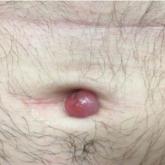Article

Calcified Urachal Remnant in a Young Adult: An Unusual Case
- Author:
- Allison J. Good, MD
- Duane C. Tucker, MD
- Eric W. Rudnick, MD
- Anna De Benedetto, MD
Urachal anomalies are important to diagnose given the potential for secondary infection or malignancy.
